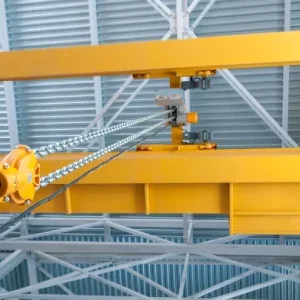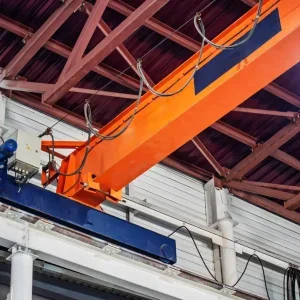Background
The rotation hook of the invention is a device for lifting and rotating suitable objects and includes hooking protrusions particularly angled in relation to each other with compound bends. These permit engagement of the hooking device with the support structure of the object to be lifted.
According to US Pipe, the invention arose due to space limitations where the new casting machine was to be installed in a space that was oriented approximately 90 degrees from the existing casting machine. An overhead bridge crane is used to carry molten metal in a lipped ladle to both the new and existing casting machines. In delivering the metal to the first casting machine, no rotation is required, but to the new machine, 90 degree rotation is needed to line up the ladle correctly, and rotated in the opposite direction to return to the filling station.
In similar applications elsewhere at US Pipe, motorised devices are used to provide rotation, but these are not expected to provide reliable operation, located as they would be a short distance above hot molten iron. Failure could result in severe production interruptions. The need for a simpler device was thus apparent.
US Pipe reports that operators learnt correct use of the device quickly, and it is now used every production day with virtually no maintenance. Only safety inspections are required.
The rotation hook can be used in other applications and lifting equipment such as jib cranes.
Description
The rotation hook device was deigned to carry a ladle of molten metal between manufacturing stations, typically using an overhead crane. At a second station the molten metal is emptied via a spout on the ladle that has to interface properly with the second station. The empty ladle is then returned to the first (filling) station.
As these two stations are oriented approximately 90 degrees to each other, the device, which is attached to a crane, causes the ladle to rotate through natural forces. The operation is reversed for the empty ladle on returning.
So the invention is basically a lifting device with more than one hooking protrusions oriented at lateral angles relative to each other. These one or more protrusions each have a compound bend to facilitate entry into the support structure or handle of the object to be transported. The invention relies on gravity and the dynamics of lifting to cause the object to rotate to the desired orientation as is lifted from the ground. Each hooking protrusion can be formed to cause zero degrees to approximately 90 degrees rotation in the intended direction.
In the preferred embodiment for the molten metal application and others in high heat, the material of construction is round or rectangular solid steel bar, and needs to be sized to accommodate the design loads (static and dynamic) and lifting cycles. Other materials, and protrusion configurations, may be used for other applications.
In the rotation hook a sturdy neck portion (1) terminates at the upper end (2) that can be attached and restrained for lifting or pulling. The attachment will resist twisting forces that occur naturally, or at least return any such tendency to its pre-engagement orientation. In the preferred embodiment shown in Fig 1, the attachable end forms a loop or ‘eye’ (3) through which a crane hook or other mode of attachment (see Fig 4) can engage the device.
Hooking protrusions (4 and 5) extend from the lower end of the neck. Although two are shown in the diagrams, additional protrusions can be added to allow additional rotation possibilities as below. The intersections at the lower end of the neck and each protrusion comprise curved portions (6 and 7), fashioned to permit engagement of the supporting structures of the object to be lifted. The compound curve on at least one of the protrusions results in an offset of the protrusion relative to the centreline of the neck. In Fig 1b both protrusions have compound bends giving the offset. Typically the entire hook protrusion lies in the same plane as the centre-line of the hook neck portion. The bend results in protrusion 5 extending at an angle ‘x’ relative to the neck centre-line.
In the application shown the object being lifted is a ladle (10) with a supporting structure or bail handle (11), which will receive the hook protrusions. The length of each protrusion must be sufficient to restrain the object once it is lifted. The offset angle x should be sufficient to facilitate entry of the offset protrusion into the space beneath the handle. In the preferred embodiment shown this angle is about 40 degrees, but the angle can be adjusted to achieve improved engagement. In Fig 3 the handle has a cross-section 12-12a at its upper portion, which will be in contact with the device upon being lifted from the ground. It is expected that most support structures will have a generally uniform cross section and dimension through the entire length, and usually circular.
The bent portions 6 and 7 are fashioned to accommodate the handle after engagement and lifting. The weight of the object being lifted will force the handle to slide down the protrusion so that the uppermost portion of the handle will engage the lowest points of the bent portions relative to ground level. The bent portions are made so that, in a suspended state, they each have a cross section at the lowest points on the reference lines 6-6a and 7-7a. Thus protrusions 4 and 5 are not parallel.
As shown in Fig 1b, the angle of intersection is designate ‘y’. This angle generally determines the amount of rotation of the object to be achieved upon lifting by one protrusion relative to lifting by the other protrusion making up the ‘y’ angle. Thus an angle ‘y’ of 90 degrees produces a rotation of 90 degrees.
Figs 2 and 3 show the protrusion engaging the support structure. Prior to engagement the protrusion 5 has a cross-section 7-7a at its lowest point parallel to the upper portion of the handle of cross-section 12-12a. The offset of the hooking protrusion overcomes the problem of trying to engage the two items in parallel, which would normally be difficult to impossible.
Procedure
In operation of the preferred embodiment, as in Figs 2 and 3, the overhead crane approaches the object to be lifted with its handle generally pointing upwards. The device is lowered to the appropriate level and the crane operator causes a protrusion to pass through the handle. In this case protrusion 5 with cross-section 7-7a is used, causing the object to rotate. Standard hooks, with a protrusion in the same plane as the centre-line of the hook neck, would not be able to grasp the handle if generally parallel to the plane of the handle, by the compound bends achieve the required offset.
As the crane begins lifting, the protrusion 5 engages the uppermost point of the handle, for it and the object load to rotate through the direction indicated by z in Fig 2, until cross-section 12-12a is perpendicular with cross-section 7-7a of the lowest pint of bend 7.
In Fig 3 the object is fully rotated and can interface with the second station at lip 14. As an example of other configurations of protrusions, if no rotation is required a protrusion can be provided with a cross-section at its lowest point perpendicular to the cross-section of the upper part of the handle. Thus in Fig 2, if lifting is required without rotation, protrusion 4 would be used, the cross-section 6-6a of which is perpendicular to cross-section 12-12a.
In manufacture, the invention can be fashioned from a single piece of metal but in drawings the neck portion comprises two lengths secured by a collar 8. Other means of manufacture, such as welding or by using fasteners, can be used to achieve the same results.
About the patent
This article is an edited version of US Patent 7,252,316 published August 7 2007 from an application filed March 26 2003. The inventors are Brian E Wallace of Pleasant Grove and James W Maise of Trussville, Alabama, both former employees of US Pipe to which the patent is assigned.
Disclaimer
This article is an edited version of the patent and may omit legally or technically important text. To see the full patent go to www.hoistmagazine.com/patents
Marketing
The patent assignee, United States Pipe and Foundry Company (US Pipe) headquartered in Birmingham, Alabama, has its main business in manufacturing pipes, couplings and other fittings. The rotation hook was developed for internal use, and no decisions relating to possible commercialisation have yet been made.
Fig 3 – The device has now lifted and rotated the ladle Fig 3 Fig 1a – Perspective view of the invention Fig 1a Fig 2 – Top plan view of the device as it engages the ladle before it is caused to rotate Fig 2 Fig 4 – Side elevation view of the device lifting a ladle Fig 4 Fig 1b – Top plan view of the invention Fig 1b






